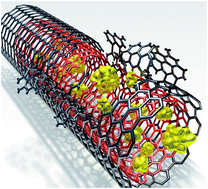Partially unzipped carbon nanotubes for high-rate and stable lithium–sulfur batteries†
Abstract
Lithium–sulfur (Li–S) batteries are attractive due to a high theoretical energy density and low sulfur cost. However, they have critical drawbacks such as drastic capacity fading during cycling, especially under high current density conditions. We report a suitable carbon matrix based on partially unzipped multi-walled carbon nanotubes (UZ.CNTs), which have favorable properties compared to multi-walled carbon nanotubes (MWCNTs) and fully unzipped nanoribbons (UZ.NRs). Partially unzipped walls of MWCNTs lead to increased surface area and pore volume with a retained electron conduction pathway. This also provides accessible inner pores as a stable reservoir for polysulfides. This reservoir is decorated with newly introduced oxygen containing functional groups, and affords a synergistic effect of shortening the depth that electrons penetrate and interacting with polysulfides for high-performance Li–S batteries. The synergistic effect is revealed by Monte Carlo simulations. The resulting partially unzipped MWCNT sulfur composite delivers 707.5 mA h g−1 at the initial discharge and retains 570.4 mA h g−1 after 200 cycles even at a high current rate of 5C (8375 mA g−1).

- This article is part of the themed collection: 2015 Journal of Materials Chemistry A Hot Papers

 Please wait while we load your content...
Please wait while we load your content...